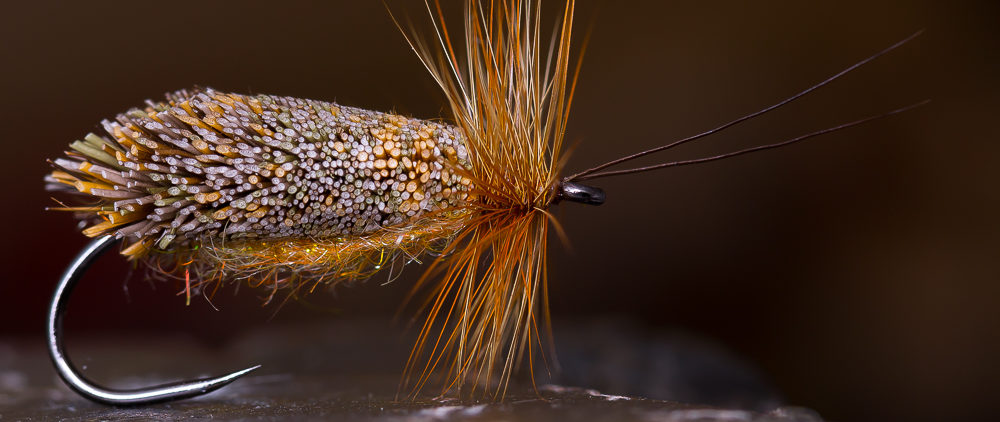
Everybody knows Bob Popovics‘ famous Surf Candy. A really great pattern to imitate bait fish and sandeels. I always loved this pattern. The only thing I didn’t like was the stiff material, which is used for it. For my seatrout fishing in the Baltic sea, I wanted the pattern to move more like the real sandeel.
I was always a fan of soft materials, so I tried polar fibre which looks fantastic underwater and moves really nice. The big problem: It was wrapping around the hook bend while casting, which was annoying. The solution was to expand the epoxy body behind the hook bend. This prevents the tangling extremely well.
Another important feature is the weight in the front of the fly which causes a strong jigging effect. The natural behavior of a sandeel when chased by a predator is that it swims as fast as it can to the bottom to hide in the sand. The jigging effect imitate this behavior.
I think I tied now over 1000 Baltic Candies and they changed a lot over the last years. The first years I used 5minute epoxy for the body and I developed some tricks to build a perfect smooth body without a lot of efforts. I showed these tricks at a lot of fairs in the last years and there was always an „Aaah!“-effect for the audience and even for some of the other tiers, but I wouldn’t tell you the tricks! ;-)
Why? The answer is quite simple. I don’t use epoxy anymore. I was annoyed by the yellowing of the epoxy after some months. It doesn’t matter which epoxy brand you are using, everything turns yellow! You don’t tie a BC in 5 minutes, that’s for sure, so it’s hard to see your with love tied flies turning yellow. The other important point is, that epoxy is very unhealthy. So I changed to uv-resin, which means all my nice epoxy tricks were useless….but that was not to bad, because working with uv-resin is quite easy, especially when you are working with „tackfree“-resin.

A Baltic Candy wet and dry
My Baltic Candies becomes smaller and thinner over the years, because of a lot of improvement. It’s harder for the fish to find out if it’s real food or not, when the fly looks a bit blurry in the water. Another advantage is, that a slim sandeel pattern with weight in the front flies through the air like a dart. Even with your hand you can throw a Baltic Candy several meters! Try this little experiment with a normal fly….you’ll see whats happened. ;-)

Bernd Ziesche with perfect baltic silver. You can see my Baltic Candy on the cork handle. ;-)
This sbs is for a „fully dressed“ Baltic Candy. You can use less flash if you prefer it. Personally I got Baltic Candies with different amounts of flash material.
Two important tips: First, strip the Baltic Candy really fast through the water with some stops. You could never, really never(!), strip the BC too fast. We could never reach the speed of a spin fishermen, so there is no „too fast“.
Secondly, it could happen that the polar fibre is a bit disarranged after you caught a fish. Just use a velcro on your jacket or vest as a comb to brush the BC.
At last, I have to thank my buddy Bernd Ziesche (great guide, superb casting instructor and owner of the fly fishing school www.first-cast.de) for his tests and comments over the years!
Materials:
- Hook: Gamakatsu SC 15 # 2 or 1
- Weight: Lead Wire
- Body: Twisted Flash silver/pearl
- Bite Point: UV-Thread orange
- Wing: Polar Fibre (white, misty blue, olive), Angel-Hair holographic-silver
- Flash: Krinkle Mirror Flash pearl
- Eyes: Stick-On-Eyes
- UV-Resin: Bug Bond
- Thread: Uni-Mono
 Wind the lead wire around the hook shank and secure it with super glue.
Wind the lead wire around the hook shank and secure it with super glue.
 Tie in the twisted flash.
Tie in the twisted flash.
 Twist the flash and wind it to the front and catch it with your thread.
Twist the flash and wind it to the front and catch it with your thread.
 Tie in a little hot bite point at the end of the shank.
Tie in a little hot bite point at the end of the shank.

 Tie in a bunch of white polar fibre on the underside of the fly.
Tie in a bunch of white polar fibre on the underside of the fly.
 Tie in the angel-hair.
Tie in the angel-hair.

 Tie in bunches of blue and olive polar fibre.
Tie in bunches of blue and olive polar fibre.
 Tie in two strands of krinkle mirror flash on each side and do a whip finish.
Tie in two strands of krinkle mirror flash on each side and do a whip finish.

 Pull the fibres with your left hand and apply the Bug Bond and cure it with your uv-torch.
Pull the fibres with your left hand and apply the Bug Bond and cure it with your uv-torch.


 Put the stick-on eyes on each side and apply the second thin coating of Bug Bond. The Baltic Candy is tackfree and now ready for fishing. If you are a crazy fly tyer like myself, you apply a third quick coating of Bug Bond, which gives really a smooth high end finish („black“ photo)! ;)
Put the stick-on eyes on each side and apply the second thin coating of Bug Bond. The Baltic Candy is tackfree and now ready for fishing. If you are a crazy fly tyer like myself, you apply a third quick coating of Bug Bond, which gives really a smooth high end finish („black“ photo)! ;)
That’s it, the Baltic Candy, my modified version of Bob Popovics‘ famous Surf Candy.
tight lines
Holger Lachmann






















































































































